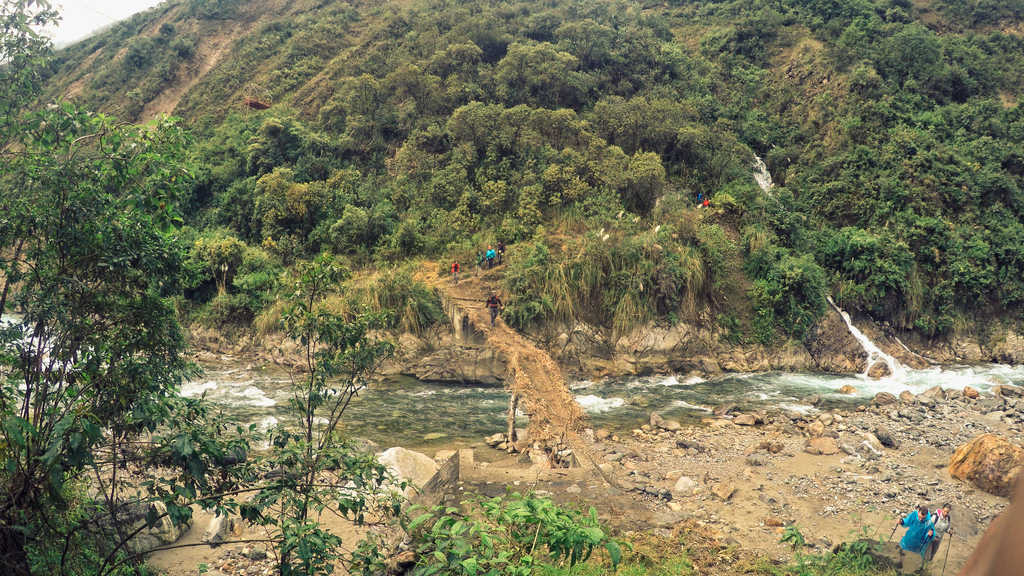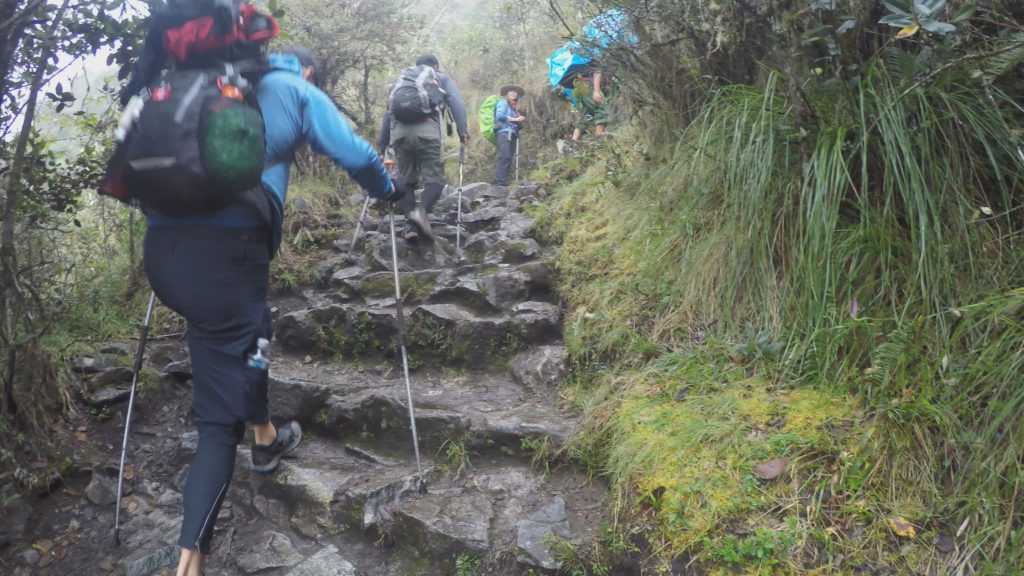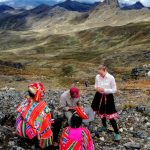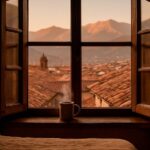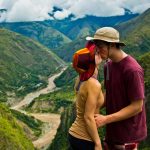The Inca Trail is the classic trek to go from Cusco to Machu Picchu. It follows the ancient imperial road of the Incan Empire. It is a section of the largest road of the ancient world. The Inca Trial crosses breathtaking landscapes of cultural and natural beauty and significance. It winds through diverse Andes ecosystems from mountain highlands to cloud forests.
On the road travelers can explore mysterious and ancient archaeological sites and encounter plants and animals unique to this part of the world.
The full trail is 4 days and 3 nights, culminating in the panoramic vista at the entrance to Machu Picchu (Puerta Del Sol)
Read on for all the information you might need for the famous Camino Inca, How to get there, What you can expect to pay, what to bring, what you can see and what to expect from the weather on the Inca Trail
Weather
Generally the weather is mild in temperature throughout the year, however between November and March expect at least some rain. Otherwise the climate is dry and hot during the day and between April and October it is perfect for visiting the Inca Trail.
The average minimum temperature is between 8° and 11°C. However in winter from June to August it can drop below freezing.
On the other hand the maximum average temperature on the Inca Trail is between 20.4° a 26.6°. Usually not getting above 25 in the winter.
How Long does the Inca Trail Take?
The Classic Inca Trail runs about 40km from Cusco. Treks that do this tistance take about 4 days, though it is possible to do it in less. The route heads over the mountains and drops into the Machu Picchu in the Peruvian Amazon.
In general, the Inca Trail is in a somewhat irregular terrain, with several ravines and streams fed by glaciers that sometimes pour into the Urubamba River, which crosses the area forming a deep valley that crosses the granite base of Vilcabamba for more than 40 kilometers through a wide variety of ecosystems.
General Information on the Inca Trail:
- 40km in 4 days 3 nights
- The route visits the ruins of Llactapata, Runkurakay, Sayacmarca, Puyapatamarka and Wiñaywayna.
- The trail ends at Inti Punku (The sun gate) at Machu Picchu
- The return trip is often done by train or bus
- There is the option to enjoy hot springs in Aguascalientes at the foot of Machu Picchu
Doing the Inca Trail on your Own
With the intention of protecting and preserving the Inca Trail, which is more than 500 years old, an entrance fee is charged and the entry is restricted to a certain number of people. The objective is to take care of this incredible monument of Inca history and all its natural environment. The road is heavily guarded.
Inca Trail Restrictions:
- You can only enter the road accompanied by a guide. Authorized travel agencies will have options for entering
- The agency you reserve through will reserve you place and also take care of the necessary equipment to tackle to the Inca Trail
- Often it is wize to reserve 6 months or more in advance, the permits are limited to 500 people per day.
- of the 50o per day who do the trial only 200 are permitted entrance to Machu Picchu
The Best Time to do The Inca Trail

There are two distinct climates in the year in Cusco and surrounding regions. Rain season (November to March) and dry season(April to October). Naturally the dry season is the better to tackle the trail, the rainy season is often much more dangerous.
What to bring for the Inca Trail
For the dry season you will want a backpack, hat, sunblock, bug spray, sunglasses, solid light clothes for the day and something warm for the night.
If you plan to try the Inca Trail during the rainy season, you will need a ponco, waterproof shoes and foodbags that are also waterproof
The Inca trail is closed in February. This is due to danger created by incredibly strong rains making the trail impassible. We urge you not to contract with companies that offer tours in this season. It can also be somewhat dangerous in December and January. These are also ties when maintenance and restoration is done on the trail and ruins and the rest of the year all is open to the public.
Alternatives to the Inca Trail. Other ways to get to Machu Picchu
- There is a route the departs from Salkantay and generally lasts 4 to 5 days depending on the tour you are interested in. This route goes from cold to hot to cold and is considered one of the best hikes in the world.
- Trail from Choquequirao to Machu Picchu is an excursion of 8 or 9 days visiting two of the most profound archeological centers in the Cusco region
- Finally is the option of Lares, 4 days, 3 nights. Just as magical with a higher elevation until arriving at Maccu Picchu
Would you like to know more?:
Itinerary
A continuación le brindaremos algunos detalles acerca de cómo son los 4 días de trek por el Camino del Inca.
Day 1, Cusco – Huayllabamba
The first day starts around 7am from Cusco at Kilometer 82, the start of the trail. After going through impact control it is a three hour walk to the first site Llactapata.
On the road there will be other minor archaeological sites and varieties of plants and animals. Next is lunch in Llactapata followed by another 30 minutes to the community of Huayllabamba. Ideally arriving here before 5pm. the First campsite and an early dinner as the next day begins quite early.
Throughout the first day we will climb from 2.670 to 2.954 meters above sea level and cross 12 kilometers of walking.
Day 2, Huayllabamba – Warmiwañusca – Pacaymayo
Early day two, before sunrise, we will take breakfast in a beautiful natural envrion. Then we will strike camp and begin to climb the Inca Trail. It can take around 4 hours to reach the highest point, Warmiwañusca at 4200 meters above sea level. Once at this height there are panoramic vistas and clear divisions between the ecosystems divided by land and altitude.
Around 2, after lunch we will begin the descent. This takes around three hours and will bring us to the valley of Pacaymayo. This track includes stone walks, tunnels and wood bridges. We spend the night close to the river.
The variety in altitude on this stretch is quite severe from 2729 meters above sea level to 3974. The final camp is just above 2600 meters. In 8 hours we cross 16 km, 4 more than the day before.
Day 3, Pacaymayo – Puyapatamarka – Wiñayhuayna
The third day starts with a descent of the Inca trail to the archaeological complex of Runkurakay and the Inca city of Sayacmarca. Foxes and deer are common in this area but shy. If you are lucky we will encounter some
From here is a road toward the village of Puya Patamarka. Here is a wonderful place to experience some local cuisine. After a brief rest it is another 2 hours to the site of Wiñay Huayna. close to there is our campsite. Another early dinner as the next day starts just as early.
Throughout the day we will go from a height of 2,729 to 3,974 meters above sea level. The distance traveled is 16 kilometers in a span of 8 hours in total.
Day 4, Wiñayhuayna – Machu Picchu – Cusco
The final day starts very early, around 5am. The ascent is through the high jungle to the Sun Gate. From here you can see the sun rise over the marvel that is Machu Picchu
The earlier the better because, if the weather is right, you can experience one of the most impressive sunrises on earth. After passing the entrance, you can enjoy a guided tour of 2 hours through the archaeological complex exploring the great and famous monuments such as the Main Square, the Circular Tower, the Sacred Solar Clock, the royal rooms and the Temple of the Three Windows.
After the tour you will have the opportunity see the place on your own, keep in mind you have to get back to Cusco. If you have scheduled a train to Cusco then leave time to make the train. You can also return by bus or the next day and stay for a rest in Aguascalientes, according to how you feel.
If you chose to return the train, the ride lasts almost two hours to Ollantaytambo and from there you can take the bus to Cusco. Although, you can take the train all the way back Cusco.
On this last day the height for which it will walk is a little less than the previous days since the path moves between 2,732 and 2,400 meters above sea level. The distance walked is 4 kilometers to the Machu Picchu sanctuary, it is almost 2 hours.
Rules for Visiting the Inca Trail and Rules for Machu Picchu
There is strict control of the route to Machu Picchu and how tourists travel. The entrance to the archaeological complex is very controlled and surely the authorities will enforce the following:
- Payment for entrance of the Inca Trail
- No littering
- No fires.
- Enjoy the scenery without touching or damaging the ruins.
- It is strictly forbidden to extract, destroy or buy any variety of flora in the Historic Sanctuary of Machu Picchu.
- Camping is allowed only in designated areas,
- Be respectful of both the ruins and other tourists
Any violation of these rules will result in the police or park ranger intervening to enforce the respective sanction.
Is the Inca Trail Dangerous?
The short answer, no. There are security and medical teams in wait in case of emergency and the guides are equipped to handle just about any emergency that arises on the trail.
What are potential dangers of the Inca Trail?
- The trails of the Inca Trail are wide and well signposted. There is no reason to worry but you should not venture on alternative routes without knowing how to get there.
- Something to take into account is the height since near the ‘Abra Warmiwañusca’ it will be at 4,200 meters above sea level. This altitude can cause physical difficulties or altitude sickness.
- Older people will likely feel the altitude more intensely and should consult a doctor before attempting the trek.
Can kids do the Inca Trail?
Yes anyone, children and teenagers should be able to complete the trail.
Some tips to take the Inca Trail with children are the following:
- The children should be at least 8 years old and prepared to spend days walking.
- Babies are not advised
- if you wish to do the Inca Trail with children, it is advised to prepare them psychologically for the journey.
How much does it cost to do the trail?
The prices vary based on the company. It is estimated that on average, the 4-day tour costs 600 US dollars per person.
How to get the best price to the Inca Trail?
- Most agencies offer a small discount for students
- Children under 18 also have a discount by presenting a passport that certifies their age.
This is all the information you need to do the Inca Trail and know Machu Picchu. If you feel ready for this adventure, we invite you to cheer up, pack your backpack and get to know one of the most famous tourist attractions in the world.

